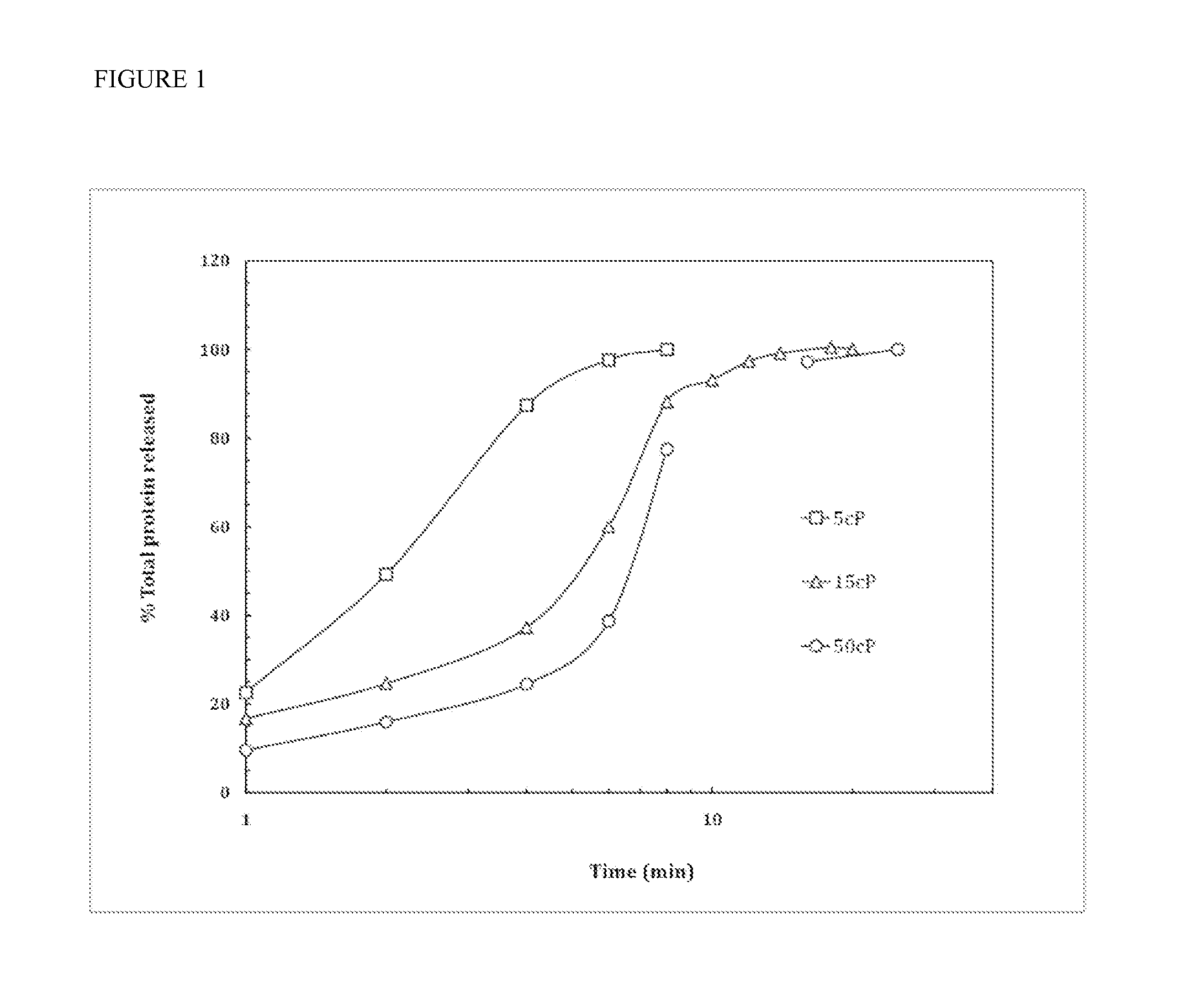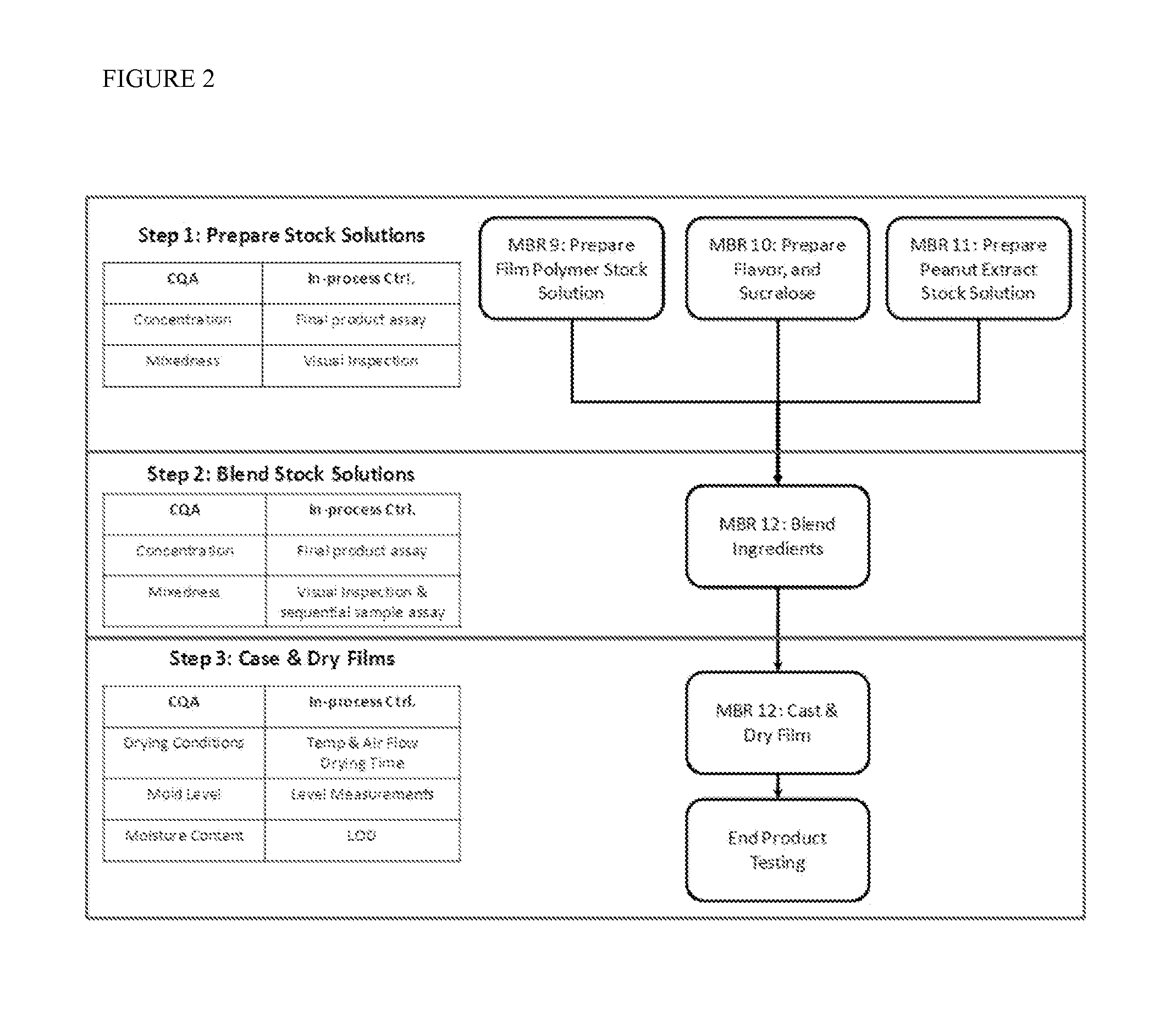Orally dissolving thin films containing allergens and methods of making and use
a technology of orally dissolving and allergens, which is applied in the directions of immunological disorders, antibody medical ingredients, peptide/protein ingredients, etc., can solve the problems of significant negative impact on individual quality of life, substantial risks to individual health, and current methods of therapy using aqueous drops are not optimized for practicality or efficiency
- Summary
- Abstract
- Description
- Claims
- Application Information
AI Technical Summary
Benefits of technology
Problems solved by technology
Method used
Image
Examples
example 1
[0056]Preparation of mucoadhesive thin film strips with different components.
TABLE 1Film ComponentF11F22F24Methocel E15 (% w / w of dry film)95.2380.810.00Methocel F50 (% w / w of dry film)0.000.0080.81Glycerol (% w / w of dry film)4.764.044.04Peanut Extract (% w / w of dry film)0.0099215.1515.15
[0057]The Formulation F11 film strip contains 2 micrograms of soluble peanut extract / strip. The Formulation F22 film strip contains 3 milligrams of soluble peanut extract / strip. The Formulation F24 film also contains 3 milligrams of soluble peanut extract / strip.
[0058]The films were prepared according to the following steps: 1) the allergen solution is prepared by suspending the peanut extract powder at 20% w / v in deionized water, then incubating the suspension at 37° C. for 30 minutes, followed by centrifuging the suspension at 3,000×g for 15 minutes, and collecting the supernatant; 2) Methocel E15, or F50, and glycerol, are mixed with the peanut extract solution according to the quantities listed a...
example 2
[0059]Modulation of allergen release time by varying polymer weight. Three sets of thin film strips were prepared according to method described in Example 1 (F22) with 19.0 mg of HPMC with different molecular weights (viscosity number, 5 cP, 15 cP, and 50 cP, respectively), while all other film components held constant with 1 mg glycerol per strip and 3.6 mg of soluble peanut extract per strip.
[0060]Dissolution time was measured by adding strips to 40 mL of phosphate-buffered saline (PBS) at 37° C. in a 50 mL Pyrex beaker. The solution was agitated by a 1 cm Teflon-coated stir bar rotating at 200 rpm. At different time points, 300 μl of samples were taken and measured on an UV / Vis spectrophotometer (Shimadzu UV mini 1240) at wavelengths of 214 nm, 230 nm, and 280 nm. The resulting absorbance values were correlated with those of a serially-diluted peanut protein standard. Results are shown in FIG. 1. The results showed that increasing the viscosity and thus the molecular weight of HP...
example 3
[0061]Sublingual Film Study. Twenty-five healthy volunteers were enrolled a study of dissolution time and preferred flavor of the sublingual films. The sublingual films contained either methocel 5 or methocel 15 in order to vary the dissolution time. Films containing methocel 5 took an average of 3.54±1.79 minutes to dissolve. While films containing methocel 15 took an average of 6.76±3.02 minutes to dissolve. Some participants also felt lingering flavor and residue in their mouths after the film dissolved, but neither of these sensations was unpleasant.
[0062]The most preferred film flavor was chocolate. Cream was the second most preferred flavor while grape and mixed berry were the least preferred. There were no adverse events or effects reported by study volunteers. Most participants found the film(s) pleasant tasting regardless of flavor. Only one volunteer rated a flavor (mixed berry) the lowest possible rating, a 5, and stated that she did not like the flavor at all.
Example 4
[0...
PUM
| Property | Measurement | Unit |
|---|---|---|
| thickness | aaaaa | aaaaa |
| thickness | aaaaa | aaaaa |
| thickness | aaaaa | aaaaa |
Abstract
Description
Claims
Application Information
 Login to View More
Login to View More - R&D
- Intellectual Property
- Life Sciences
- Materials
- Tech Scout
- Unparalleled Data Quality
- Higher Quality Content
- 60% Fewer Hallucinations
Browse by: Latest US Patents, China's latest patents, Technical Efficacy Thesaurus, Application Domain, Technology Topic, Popular Technical Reports.
© 2025 PatSnap. All rights reserved.Legal|Privacy policy|Modern Slavery Act Transparency Statement|Sitemap|About US| Contact US: help@patsnap.com


